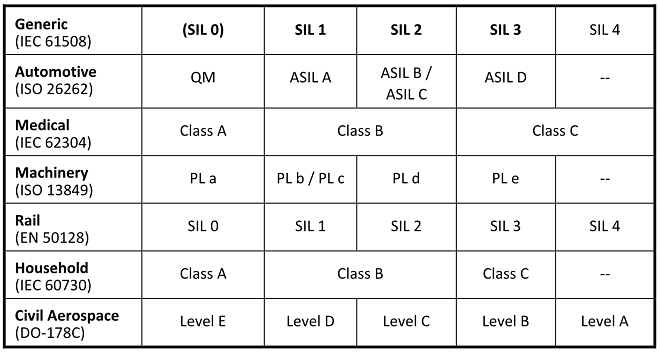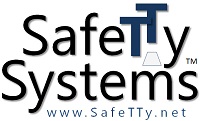SafeTTy Certified™ Programme

The internationally-recognised SafeTTy Certified programme is designed to help people obtain the skills needed to develop reliable, secure and safe embedded systems using ‘Time Triggered‘ (TT) software architectures – and provide evidence that they possess such skills.
The programme starts at “Level 1” and progresses to “Level 3”.
In our view:
- Level 1 represents the minimum qualification level that should be expected from an individual involved in the development of real-time embedded systems that are intended to be reliable, but where failure has no direct safety implications.
- Level 2 represents the minimum qualification level that should be expected from an individual involved in the development of real-time embedded systems that may have some safety implications (for example, designs developed in compliance with IEC 61508 or in compliance with ISO 26262), and / or where system failure could prove very expensive (e.g. deep-sea products, satellite systems).
- Level 3 represents an appropriate qualification level for an individual who is involved in the development of real-time embedded systems that are safety-critical in nature (for example, designs developed in compliance with IEC 61508 up to ‘SIL 3’ / ‘SIL 4’ or in compliance with ISO 26262 up to “ASIL D”, or in compliance with DO-178C up to “Level A”).
![]()
Please note that:
- For more experienced developers, we offer the option of Direct Entry to L2 courses: this means that it is not necessary to complete L1 of this programme before attempting the intermediate-level training and examination.
- All three levels can be taken online: this option is particularly popular where a single developer in an organisation wishes to complete the programme. Completing all three levels in this way will typically take 18-24 months (on a part-time basis).
Further information about the SafeTTy Certified programme is provided on this page.
Looking for information about ‘certified systems’ (rather than ‘certified people’)? You may find our Consultancy page more useful.
[This page was last updated: 2025-02-18]![]()
![]()
Who should join the SafeTTy Certified programme?
![]()
The SafeTTy Certified programme has a focus on the development of time-triggered (TT) embedded systems.
Through successful completion of this internationally-recognised programme:
- Organisations can demonstrate – to certification authorities and / or to customers and clients – that their staff have the qualifications and skills needed to develop reliable real-time embedded systems.
- Individual developers and project managers can improve their career prospects by providing clear evidence of their particular skills and expertise in this important area.
![]()
![]()
Does your organisation need to achieve functional safety?
![]()
Development of safety-related embedded systems involves use of appropriate development processes, software tools and hardware platforms — but it also requires that the people involved have relevant skills and experience.
In many ways, this may seem like common sense, but modern safety standards now make this requirement explicit, requiring that organisations can provide evidence of compliance.
For example, ISO 26262 (2018) requires that there should be a “safety culture” within the organisation:
“The organisation shall create, foster, and sustain a safety culture that supports and encourages the effective achievement of functional safety.” [ISO 26262-2: 2018, Section 5.4.2.1.]
This standard provides suggestions for various ways in which an organisation can demonstrate that it has created such a safety culture: these include being able to demonstrate that people doing a particular piece of work have “the competence commensurate with the activity assigned”.
The requirements of ISO 26262 are having an enormous impact on work in the automotive sector, but concerns about the reliability of embedded systems extend much more widely.
For example, organisations developing household appliances (such as washing machines) in compliance with IEC 60335 are told (in the first line of the introduction):
“It has been assumed in the drafting of this International Standard that the execution of its provisions is entrusted to appropriately qualified and experienced persons.” [IEC 60335-1: 2010, Introduction.]
Clearly, even what might be seen as apparently “simple” household appliances have safety implications. For example, manufacturers need to ensure that the door of a washing machine cannot be opened by a child during a “spin” cycle, and must do all they can to avoid the risk of fires in “always on” applications, such as fridges and freezers.
Demonstrating that your team has the key technical skills required to develop modern safety-related or safety-critical control or monitoring systems is an important consideration (in any sector). Achieving Level 2 or Level 3 in the SafeTTy Certified programme can be a highly-effective effective way of meeting this requirement.
![]()

![]()
![]()
Delivery and assessment arrangements for the SafeTTy Certified programme
![]()
The SafeTTy Certified programme is delivered in association with both our introductory training course (TTa) and our more advanced course (TTb). These courses are offered on a worldwide basis through:
- on-line training – a cost-effective solution for individuals, and for small groups (typically 1-3 people), and,
- on-site training – a fast, flexible and effective solution for organisations wishing to certify teams (typically 4-20 people), and,
- public courses – a fast and effective solution for organisations wishing to certify individuals or small teams (typically 1-3 people).
The assessment process is rigorous (the equivalent of “Distinction” level in an MSc course at a good UK university). Where courses are completed on line, assessment is through a one-to-one, in-depth, technical interview (usually conducted by Skype®). Where courses are conducted on site, assessment is usually by means of a formal (university style) written examination: this is a “closed book” examination (conducted on paper, without access to the WWW, books or other materials).
Successful candidates are provided with a signed and numbered certificate that is internationally recognised.![]()
![]()
SafeTTy Certified (Level 0)
![]()
As a result of a number of requests, we now offer “Level 0” certificates to individuals who join one of our courses and actively participate in the training programme (including submission of attempted solutions to the majority of the formal exercises).
No written examination is involved in a “Level 0” award (but clear evidence of participation is required: this is not a so-called “attendance certificate” …).
![]()
![]()
SafeTTy Certified (Level 1)
![]()
“Level 1” is associated with Course TTa.
In our view, “Level 1” on the SafeTTy Certified programme represents the minimum qualification level that should be expected from an individual involved in the development of real-time embedded systems that are intended to be reliable, but where failure has no direct safety implications.
The “Level 1” qualification is rigorously assessed by means of a formal examination. The pass mark is 70% (the equivalent of a “Distinction” grade in an MSc course offered by a good UK university).
“Level 1” can be completed cost-effectively – on a worldwide basis – by taking TTa as an online course, with support by e-mail from your Certification Tutor: assessment is then by means of a 2-hour (1-to-1) technical interview, conducted via Skype®.
Around 50% of candidates who attempt the Level 1 exam are successful on the first sitting. A single resit opportunity is offered (without charge) on most programmes.
![]()
![]()
SafeTTy Certified (Level 2)
![]()
“Level 2” is associated with Course TTb.
In our view, Level 2 represents the minimum qualification level that should be expected from an individual involved in the development of real-time embedded systems that may have some safety implications (for example, designs developed in compliance with IEC 61508 or in compliance with ISO 26262), and / or where system failure could prove very expensive (e.g. deep-sea products, satellite systems).
As with “Level 1”, the “Level 2” qualification is rigorously assessed by means of a formal examination, with a pass mark of 70%.
Around 70% of candidates who attempt the Level 2 exam are successful on the first sitting. A single resit opportunity is offered (without charge) on most programmes.
![]()
![]()
Direct Entry to ‘Level 2’ for experienced developers
![]()
We offer the option of Direct Entry to Level 2 courses for more experienced developers: this means that it is not necessary to complete Level 1 of this programme before attempting the more advanced examination.
We recommend that developers have a minimum of two years of experience in industry (after graduating with a related university / college degree) before they attempt Direct Entry to this programme.
Please contact us for further information about Direct Entry to Level 2.
![]()
![]()
SafeTTy Certified (Level 3)
![]()
In some circumstances, we are able to award Level 3 qualifications to individuals who: [i] have successfully completed Level 2 in the SafeTTy Certified programme; [ii] complete a significant project involving the use of TT architectures; [iii] submit a report on this project;
[iv] undergo a technical exam about this project.
The project work will typically be completed over a period of around 12 months. Support is provided by email during the project.
In our view, Level 3 represents an appropriate qualification level for an individual who is involved in the development of real-time embedded systems that are safety-critical in nature (for example, designs developed in compliance with IEC 61508 up to ‘SIL 3’ / ‘SIL 4’ or in compliance with ISO 26262 up to “ASIL D”, or in compliance with DO-178C up to “Level A”).
If you wish to discuss possible ‘Level 3 Project’, please contact us.
![]()
![]()
SafeTTy Solutions™ packages

The SafeTTy Certified examinations can be taken by complete development teams as part of a SafeTTy Solutions™ package.
Most teams aim to achieve a ‘Level 2’ standard through this route (but it is possible to achieve ‘Level 3’).
Further information is available on our SafeTTy Solutions page.
![]()
![]()
![]()
Further information
Please contact us if you have any questions about the SafeTTy Certified programme.
